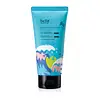What's inside
What's inside
 Key Ingredients
Key Ingredients

No key ingredients
 Benefits
Benefits

 Concerns
Concerns

 Ingredients Side-by-side
Ingredients Side-by-side

Aloe Barbadensis Leaf Juice
Skin ConditioningWater
Skin ConditioningDecyl Glucoside
CleansingGlycerin
HumectantPropanediol
SolventCaprylyl/Capryl Glucoside
CleansingCocoyl Methyl Glucamide
Skin ConditioningAllantoin
Skin ConditioningZingiber Officinale Root Extract
MaskingBisabolol
MaskingSorbic Acid
PreservativeSorbitan Caprylate
EmulsifyingBenzoic Acid
MaskingCitric Acid
BufferingRosa Damascena Extract
MaskingRosa Damascena Flower Oil
MaskingSodium Hydroxide
BufferingAloe Barbadensis Leaf Juice, Water, Decyl Glucoside, Glycerin, Propanediol, Caprylyl/Capryl Glucoside, Cocoyl Methyl Glucamide, Allantoin, Zingiber Officinale Root Extract, Bisabolol, Sorbic Acid, Sorbitan Caprylate, Benzoic Acid, Citric Acid, Rosa Damascena Extract, Rosa Damascena Flower Oil, Sodium Hydroxide
Water
Skin ConditioningGlycerin
HumectantPotassium Cocoyl Glycinate
Coco-Betaine
Cleansing1,2-Hexanediol
Skin ConditioningPotassium Cocoate
EmulsifyingLauramidopropyl Betaine
CleansingAcrylates/C10-30 Alkyl Acrylate Crosspolymer
Emulsion StabilisingStellaria Media Extract
Skin ConditioningAlchemilla Vulgaris Leaf Extract
AntioxidantEquisetum Arvense Leaf Extract
AstringentUrtica Dioica Leaf Extract
Skin ConditioningAvena Sativa Kernel Extract
AbrasiveCalendula Officinalis Flower Extract
MaskingNepeta Cataria Extract
TonicRubus Idaeus Leaf Extract
Skin ConditioningBaptisia Tinctoria Root Extract
Skin ConditioningPotassium Hydroxide
BufferingSodium Chloride
MaskingEthylhexylglycerin
Skin ConditioningGlyceryl Oleate
EmollientCoco-Glucoside
CleansingButylene Glycol
HumectantTetrasodium EDTA
Malachite Extract
AntioxidantCitric Acid
BufferingCitrus Aurantium Dulcis Peel Oil
MaskingCitrus Aurantifolia Oil
CleansingPelargonium Graveolens Flower Oil
MaskingRosmarinus Officinalis Leaf Oil
MaskingLimonene
PerfumingCitronellol
PerfumingGeraniol
PerfumingCitral
PerfumingWater, Glycerin, Potassium Cocoyl Glycinate, Coco-Betaine, 1,2-Hexanediol, Potassium Cocoate, Lauramidopropyl Betaine, Acrylates/C10-30 Alkyl Acrylate Crosspolymer, Stellaria Media Extract, Alchemilla Vulgaris Leaf Extract, Equisetum Arvense Leaf Extract, Urtica Dioica Leaf Extract, Avena Sativa Kernel Extract, Calendula Officinalis Flower Extract, Nepeta Cataria Extract, Rubus Idaeus Leaf Extract, Baptisia Tinctoria Root Extract, Potassium Hydroxide, Sodium Chloride, Ethylhexylglycerin, Glyceryl Oleate, Coco-Glucoside, Butylene Glycol, Tetrasodium EDTA, Malachite Extract, Citric Acid, Citrus Aurantium Dulcis Peel Oil, Citrus Aurantifolia Oil, Pelargonium Graveolens Flower Oil, Rosmarinus Officinalis Leaf Oil, Limonene, Citronellol, Geraniol, Citral
 Reviews
Reviews

Ingredients Explained
These ingredients are found in both products.
Ingredients higher up in an ingredient list are typically present in a larger amount.
Citric Acid is an alpha hydroxy acid (AHA) naturally found in citrus fruits like oranges, lemons, and limes.
Like other AHAs, citric acid can exfoliate skin by breaking down the bonds that hold dead skin cells together. This helps reveal smoother and brighter skin underneath.
However, this exfoliating effect only happens at high concentrations (20%) which can be hard to find in cosmetic products.
Due to this, citric acid is usually included in small amounts as a pH adjuster. This helps keep products slightly more acidic and compatible with skin's natural pH.
In skincare formulas, citric acid can:
While it can provide some skin benefits, research shows lactic acid and glycolic acid are generally more effective and less irritating exfoliants.
Most citric acid used in skincare today is made by fermenting sugars (usually from molasses). This synthetic version is identical to the natural citrus form but easier to stabilize and use in formulations.
Read more about some other popular AHA's here:
Learn more about Citric AcidGlycerin is already naturally found in your skin. It helps moisturize and protect your skin.
A study from 2016 found glycerin to be more effective as a humectant than AHAs and hyaluronic acid.
As a humectant, it helps the skin stay hydrated by pulling moisture to your skin. The low molecular weight of glycerin allows it to pull moisture into the deeper layers of your skin.
Hydrated skin improves your skin barrier; Your skin barrier helps protect against irritants and bacteria.
Glycerin has also been found to have antimicrobial and antiviral properties. Due to these properties, glycerin is often used in wound and burn treatments.
In cosmetics, glycerin is usually derived from plants such as soybean or palm. However, it can also be sourced from animals, such as tallow or animal fat.
This ingredient is organic, colorless, odorless, and non-toxic.
Glycerin is the name for this ingredient in American English. British English uses Glycerol/Glycerine.
Learn more about GlycerinWater. It's the most common cosmetic ingredient of all. You'll usually see it at the top of ingredient lists, meaning that it makes up the largest part of the product.
So why is it so popular? Water most often acts as a solvent - this means that it helps dissolve other ingredients into the formulation.
You'll also recognize water as that liquid we all need to stay alive. If you see this, drink a glass of water. Stay hydrated!
Learn more about Water